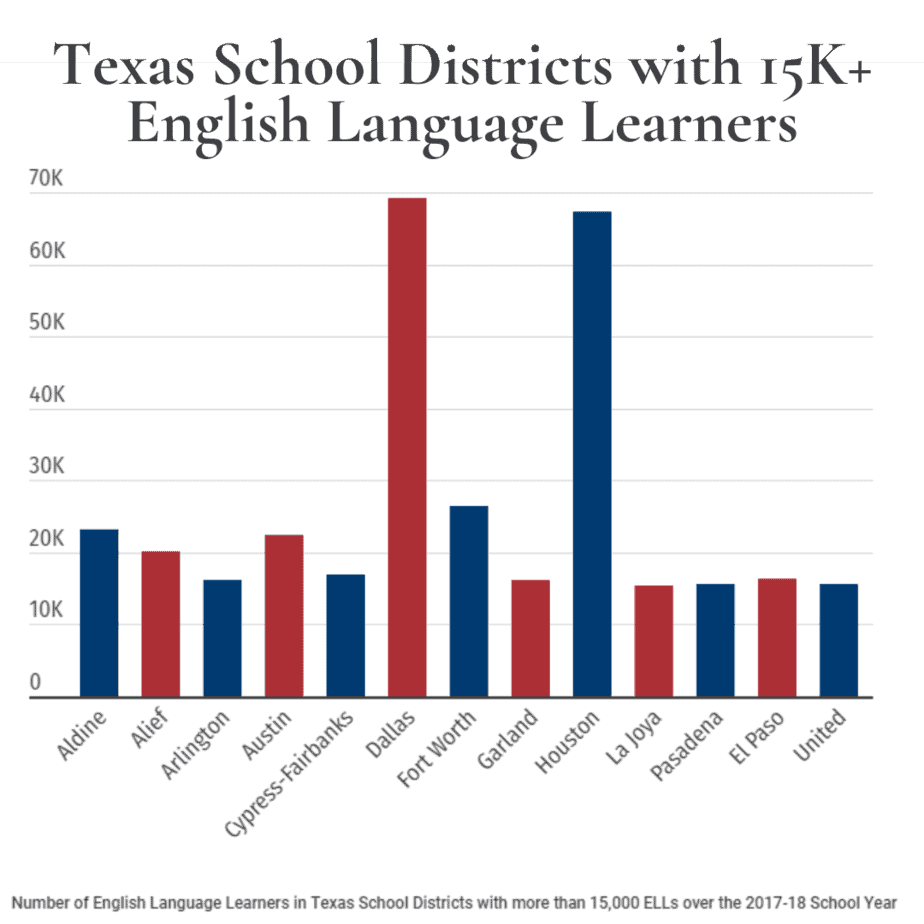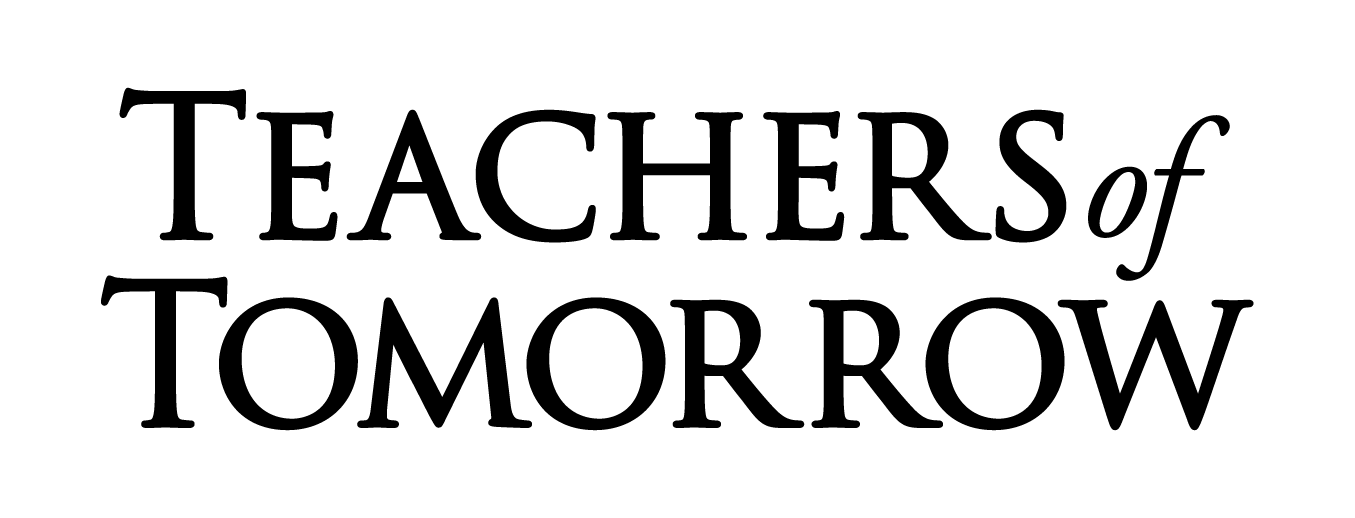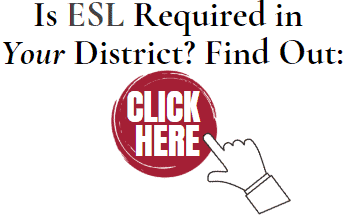We’ve tracked the latest district hiring trends to pass along to you! Our latest findings show that becoming certified as an English as a Second Language (ESL) teacher improves your chances of getting hired faster! It is becoming increasingly more common for schools to request or require teachers to have an ESL certification. Among Texas districts, it is customary to require teachers pursuing Early Childhood Education and English Language Arts to pair their Texas ESL certification.
What is ESL Certification?
Texas ESL certification focuses on the acronym ESL, which means English as a Second Language. As such, teachers that receive ESL certification specifically teach in a setting where a student’s native language is not English. The Texas ESL certification test must be taken by any candidate who wants to teach English in Texas companies or organizations. It’s important to know that not all ESL positions require individuals to obtain a teaching degree prior to taking ESL Certification in Texas, however, many positions are designed for working teachers who want to expand their qualifications.
Unpacking the Trend
Where did this trend come from? Why is becoming ESL certified important? How will becoming ESL certified improve my chances of getting hired?
With over 1 million English language learners (ELLs), these students comprise one of the largest student populations in Texas1. In fact, ELLs account for 18% of Texas public school students. This is the greatest state percentage of ELLs in the U.S., second only to California2. Over the past two decades, the number of ELLs has steadily continued to rise, which is why it is safe to conclude the need for ESL certified teachers is also on the rise.
These statistics clearly outline the dawn of the trend and exemplify its importance. Unfortunately, nearly 30% of ELLs do not make it to graduation3. As educators, it is our duty to step up and find solutions when we identify areas of weakness. For this reason, the Texas Education Agency (TEA) is more widely mandating teachers to have ESL certifications, even if certified to teach another subject.
Districts are requiring their teachers to earn an ESL certification because it is clear the demand for ESL teachers is not disappearing any time soon. At least 13 school districts in Texas have more than 15,000 English Language Learners, as depicted in the chart below:

This chart leaves no uncertainty as to why English as a Second Languages habitually makes the TEA’s list of High Need Areas. Read this post to learn more about which subject areas are on the 2020-2021 High Need Areas List. To better serve all our students, the TEA and school districts are taking proactive measures and requiring teachers to earn an ESL certification. Even if your school district or specific certification area does not yet require ESL, this will likely change – and soon. Don’t allow anything to stand in the way of your hard work and dedication to the profession. Become the ESL certified teacher that districts are looking to hire.
How to Become ESL Certified In Texas
The process of earning your ESL certification with Texas Teachers is simple. Becoming an ESL teacher only requires you to take the ESL supplemental exam 154 and it must be paired with any other subject area you’re pursuing. ESL is not a stand-alone subject, which means you must become certified in another area of interest. When you speak with a Texas Teacher Advisor to develop your personalized path to certification, request approval to add ESL exam 154. Taking the ESL exam will ensure that you don’t miss out on any positions which require ESL! You may request up to three exams at one time while working on your Pre-service requirements. If your plans change along the way, no problem! These can always be changed but it’s best to add them in the beginning. We’ll be here every step of the way to guide you on your journey to become a teacher.
Steps to ESL Certification
If you don’t know where to start with ESL certification in Texas, have no fear. Below are a few steps you can take to be closer to your ESL certification.
1. Request exam approval through TOT
Becoming an ESL teacher is extremely important, due to the ability for ESL teachers to help those who struggle with the English language. Because ESL requires an additional exam, you must request exam approval through Teachers of Tomorrow.
2. Study for the test
It’s important to create a study plan for the exam a few months prior to taking it. Taking practice exams, learning what kinds of questions will be on the exam, and looking into what is to be expected the day of the exam, are all ways to help you succeed in passing the exam.
3. Pass the TExES ESL Supplemental Exam
As stated throughout this post, the ESL certification test is for teachers planning on teaching in a setting where the student’s native language is not English.
4. Add it to your certification
Once you have passed the ESL Supplemental Exam, you can add it to your certification by verifying your scores and completing a background check.
ESL Explained
One common misconception associated with ESL is the belief that you must be bi- or multilingual. Becoming an ESL teacher is accessible to all candidates, as you are only required to know how to speak English. ESL and Bilingual Education are often lumped into one category, as both do promote bilingualism and are high-need areas. However, their approach to teaching English is quite different and focuses on specific English learner populations. For a more in-depth look into Bilingual Education and ESL, check out this blog post.
The goal of ESL programs is to help students acquire English proficiency. This is achieved through only using English as the language of classroom instruction, as it is possible that not all students share the same native language. If you are not ESL certified, you may not meet the requirements to serve as the only lead teacher in the classroom.
Let’s take a look at one scenario to help understand the TEA-approved ESL Content-Based model (which is one of two approved models):
Lidia is a certified English Language Arts teacher. Last year, she had no English language learners in her classroom. This year, she has three incoming English language learners. Her school has presented her with two options:
1. Lidia may co-teach her class with an ESL certified teacher.
2. Lidia may take the additional ESL exam to become certified before returning to teach.
Districts are trying to avoid encountering such scenarios. It is the district’s responsibility to ensure they have enough ESL certified teachers, which is why they prefer to hire teachers who are already ESL certified.
As an ESL certified teacher, you can help make a positive impact on a student’s life. 30% of ESL students have been identified as at-risk dropouts. These are children who need your support as a teacher. Helping to reach these students is as simple as taking a supplemental exam. Make sure to request approval for exam 154 and become the teacher your students have been waiting for.
Benefits of Becoming a Teacher with an ESL Certification in Texas 
As we mentioned earlier, ESL is on the list of High-Need Area teachers. Read this post to learn about 9 great benefits of becoming a High Need Area teacher! Here are just a few other reasons why you should consider becoming ESL certified:
- You will be eligible for more jobs, as many teaching positions require ESL.
- You may be eligible for loan forgiveness programs. Learn more.
- Schools may offer salary supplements or annual stipends.
- You can easily checkoff a task which may become a future requirement.
- You may continue to work as the lead teacher in your classroom with ESL students.
- An ESL certification will help you stand out from other candidates applying for the same teaching position.
- You can make a true difference in a student’s life!
Common Certification Areas That Typically Need ESL
Texas School districts commonly require teachers to pair their certification with ESL in the following two areas:
![]() Core Subjects EC-6
Core Subjects EC-6
Why is this a commonly required area?
Helping build strong English skills starts when students are young. By working with younger students, you are able to give them the best possible chance to improve their English proficiency and set them up for future success.
![]() English Language Arts & Reading (ELAR) (4-8) OR (7-12)
English Language Arts & Reading (ELAR) (4-8) OR (7-12)
Why is this a commonly required area?
As an English Language Arts Teacher, you are responsible for teaching students core skills such as reading and writing. You help build the foundation of their education. If a student has limited English proficiency, their future academic success may be hindered.
Remember, even if you aren’t pursuing your certification in Core Subjects EC-6 or ELAR, is it still a good idea to earn your ESL certification, as district requirements may change.
Is ESL Needed in Your School District?
We have composed a list of Texas school districts that require and/or recommend ESL. We will continue to update this list, so be sure to check back regularly if you don’t see your district!
Texas School District
TEXAS SCHOOL DISTRICTS |
Subject(s)(BOLD = ESL is REQUIRED; NORMAL = ESL is RECOMMENDED) |
| ARLINGTON ISD |
|
| DALLAS ISD |
|
| FRISCO ISD |
|
| BIRDVILLE ISD |
|
| AMARILLO ISD |
|
| GRAND PRAIRIE ISD |
|
| CROWLEY ISD |
|
| DESOTO ISD |
|
| LITTLE ELM ISD |
|
| UPLIFT EDUCATION |
|



